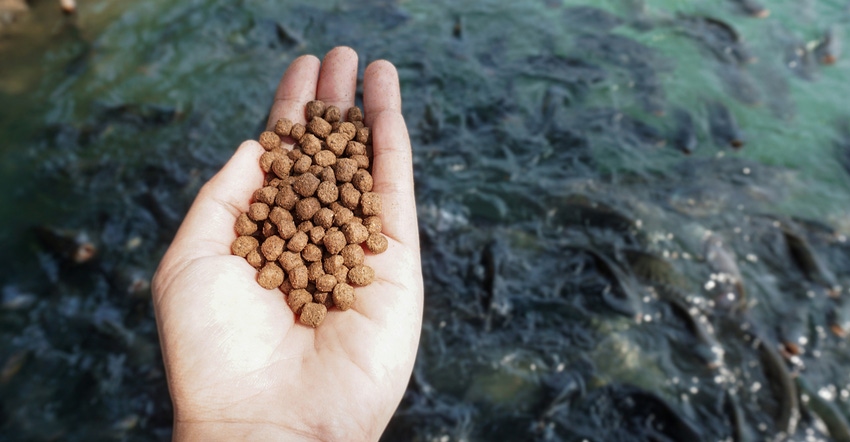March 11, 2022

My uncle’s pond was right next to our farm’s property line. When my girls were younger, after long afternoons tending to sheep at the homeplace, we’d venture over to the water’s edge to relax.
My uncle would soon come out with a bucket, set it on the ground and motion for his grandnieces to put their hands inside. Their little fingers scooped up a fistful of pellets, and then they tossed them in the water to feed the fish.
About 3.3 billion people rely on seafood for almost 20% of their protein, according to the U.S. Soybean Export Council (USSEC), making it the world’s largest traded food commodity.
According to the Food and Agriculture Organization, aquaculture is expected to overtake capture production in 2027 and account for 52% of all fish production for all uses by 2030. In all, that market is projected to exceed $245 billion by 2027, up from nearly $180 billion today.
It will require a lot of fish food to serve this growing industry — more than my girls’ tiny hands could hold — and farmers filling that demand. You see, those little pellets they threw out into the pond have one key ingredient — soybeans.
Soybean meal is a key protein source for the aquaculture and aquafeed industries worldwide. Its protein content, amino acid profile and digestibility work for most fish and shrimp species. Today, according the USSEC, many aquaculture diets contain 25% to 30% soy.
A Missouri company is helping fill the demand by developing soy genetics for fish food while the farmer-funded checkoff grows the market worldwide.
Protein-packed soy
St. Louis-based Benson Hill is a food tech company that is building ultra-high-protein soybean varieties. These varieties fill demand in the human food sector — think protein bars — but now they are used in the fish food sector.
This year, Riverence Holdings LLC, the largest land-based producer of steelhead and rainbow trout in the Americas, committed to buying Benson Hill’s ultra-high-protein soy ingredients as feed for its fish. That’s good news for soybean farmers growing Benson Hill varieties.
The Idaho-based company, like other food supply businesses, is looking for inputs that minimize its overall environmental footprint. Benson Hill’s ultra-high protein and low anti-nutrient levels reduce the need for processing steps to concentrate protein levels. What does that mean? Less water requirements and fewer greenhouse gas emissions.
Jesse Trushenski, Riverence CEO, says that Benson Hill soy ingredients check all the boxes from a nutrition, sustainability and cost perspective for his company. “It’s exciting to have a product designed for our market that supports improved performance of our fish, is traceable, and has a very clean carbon and water profile,” he says.
Benson Hill’s proprietary ingredients will be incorporated into the aquaculture diets manufactured by Riverence’s preferred supplier Rangen, a brand of Wilbur-Ellis Nutrition.
While this is a domestic market for soybeans, USSEC continues to expand opportunities for soy in aquaculture around the world.
Developing emerging markets
Through its work with the World Initiative for Soil in Human Health or WISHH, USSEC is promoting U.S. soybeans as fish food in developing and emerging markets.
The aquaculture industry is growing overseas, says Courtney Knupp, USSEC director of aquaculture and animal nutrition meal. WISHH is reaching into underdeveloped countries such as Tanzania, Nigeria and Cambodia to help farmers raise, care for and market fish by providing high-quality, soy-based nutrition.
In addition, the USSEC works in more developed markets, including China, Thailand and Ecuador, and in growing markets such as the Middle East and North Africa.
It is amazing to see how much impact U.S. soybeans have in helping farmers in Cambodia, one of the poorest countries in the world, realize a sustainable income. Take for instance WISHH aquaculture businesswoman Lim Bunny in Kampong Cham, Cambodia, who grew her wholesale distribution business to sell 2 to 3 tons of fish daily, resulting in sales revenue increasing by 30%. She uses soy-based protein in her fish food diet. Bunny markets it as farm-raised fish.
American soybean farmers are truly supplying ingredients to feed fish, livestock and humans here at home and abroad.
And while Bunny is nearly 9,000 miles and an ocean away from my uncle’s small farm pond, both are dedicated to feeding their fish quality products that included soy. Why? Well, Bunny is feeding her fellow countrymen and women, and my uncle was frying up fish for my girls.
You May Also Like




